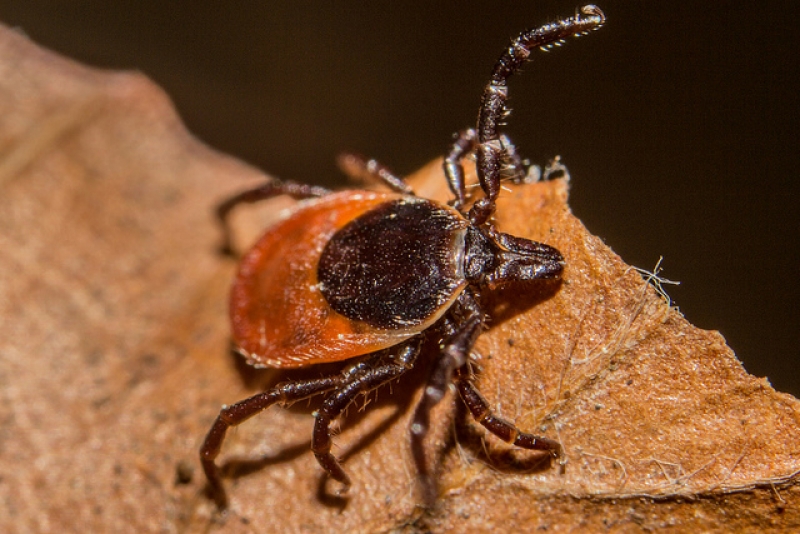
Female blacklegged tick (Ixodes scapularis), commonly known as the deer tick. Photo: Lennart Tange, Flickr Creative Commons
Late Season Tick PSA
In northern New York State, autumn temperatures have been between seven and eight degrees above average, allowing us even more time to procrastinate fall chores. This has been welcome to those who have to work outside, and anyone concerned about their heating bill is loving the warm weather too. Obviously, skiers and other winter enthusiasts aren’t happy, but I think the rest of us should get ticked off as well.
The past few years have seen an explosion in the deer (black-legged) tick population in the north country. During the warmer months we now have to take precautions when outdoors that were not necessary in the past. But usually by this time of year we can put away the repellant sprays and stop treating our pets for ticks and fleas. Well, keep those things in stock, because 2015 is an exception.
The deer tick is known to transmit Lyme disease as well as babesiosis, anaplasmosis, Powassan virus and other serious illnesses. In fact it’s possible for two or more diseases to be transferred to a host, human or otherwise, by a single tick bite.
Most infections come from an immature or “nymph” stage deer tick, which can be tinier than a poppy seed, making them hard to see without magnification. The adults are not exactly huge, being a bit smaller than a sesame seed. To avoid tick bites, hunters and others who work or play outdoors need to continue being vigilant until freezing weather sets in.
This isn’t to say we need to panic (though feel free to do so if you like). According to the National Institutes for health (NIH), only about 20% of deer ticks are infected with Borrelia burgdorferi, the spirochete bacterium that causes Lyme. In most cases, ticks must feed for 24-36 hours in order to transmit disease. And even if that happens, prompt treatment cures Lyme in the majority of infected people.
However, it’s not always as simple as taking pills and feeling improvement. Unlike a tissue infection where antibiotics usually provide relief within days, Lyme symptoms can persist for weeks or months after the standard 3-week treatment has ended. In rare cases it can be a year or more. This is called “Post-Lyme Syndrome,” and its causes are not well understood. Lyme is not a disease to take lightly.
Avoiding ticks is the first order of business. Ticks “quest” at the tips of tall grass or brush, waiting to cling to the next warm body that brushes against them. The Centers for Disease Control and Prevention (CDC) recommend using products containing 20-30% DEET on exposed skin. Clothing, footwear and gear such as tents can be treated with products containing the active ingredient permethrin. Hikers should stick to marked trails.
Homeowners can clear brush, weeds and tall grasses from the edges of their yards. Ticks like to hide out under leaf litter (which is why sprays are not generally effective against them), so maintaining a yard perimeter that’s raked clean can help discourage ticks.
Until real winter gets here, pets should be treated regularly with a systemic anti-tick product so they don’t bring deer ticks into the home. Talk to your vet about recommendations for treatments, and about getting your pets vaccinated against Lyme (sadly there is no human vaccine at the moment).
Despite its name, deer ticks feed on—and infect—many wild critters, particularly our native and ubiquitous white-footed mouse. Because of ticks’ prevalence, people who spend a lot of time outside will eventually “meet” deer ticks. This is where tick hygiene comes in.
Shower and wash thoroughly every evening and then check for ticks. Unfortunately they like hard-to-see places such as the armpits, groin, scalp and the backs of the knees, so look closely in these areas. If you find a tick has latched onto you, grasp it as close to the skin as possible with tweezers and pull straight up until it releases. You may have to pull hard if it’s been feeding for some time. Don’t twist it or use heat, petroleum jelly or other home remedies to get it to release, as this can increase the chances of disease transmission.
Typical early symptoms of Lyme disease include severe headache, chills, fever, extreme fatigue, joint pain and dizziness. According to the International Lyme and Associated Diseases Society (ILADS is a nonprofit international medical society), fewer than 50% of people with Lyme Disease recall having a red, expanding “bull’s-eye” rash (erythema migrans) that may occur between 3-30 days after the bite. Symptoms can vary widely with each individual. Early signs may go away on their own, but the Lyme organism will cause more serious health issues in the future if ignored. These include arthritis, heart problems and debilitating problems with memory and concentration.
If you’ve been bitten by a tick and have these symptoms, see your doctor right away. She or he can order a blood test, or may even prescribe antibiotics based on symptoms. For more information, go to the CDC website at http://www.cdc.gov/lyme/ or to the NIH site at https://www.niaid.nih.gov/topics/lymeDisease/ A comprehensive website is also hosted by at www.ilads.org.
Enjoy the mild weather, but keep yourself and your loved ones ticked off.

